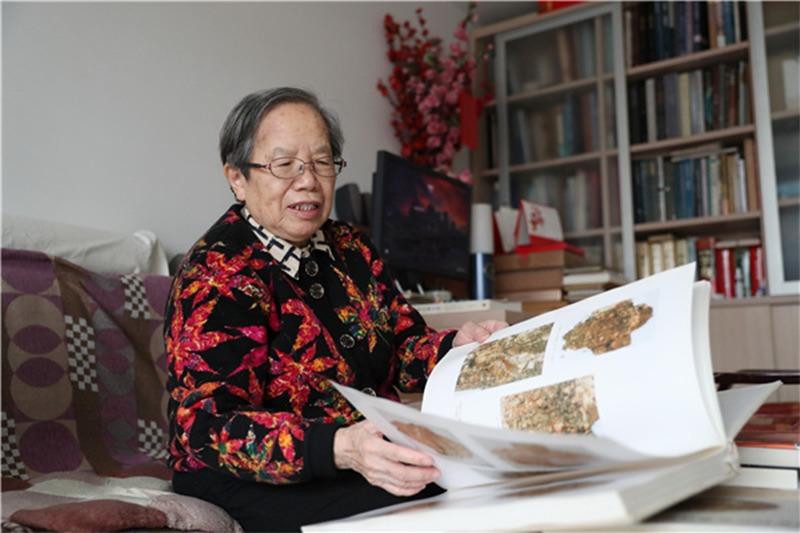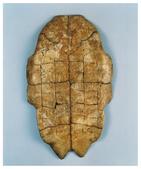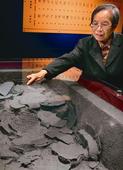Archaeologist and author Liu Yiman has not let retirement douse a passion for her favorite subject, Ye Zizhen reports.
 Liu Yiman, who worked as an archaeologist with the Chinese Academy of Social Sciences, goes through a book she compiled on archaeological discoveries of oracle bones in China. (CHEN ZEBING / CHINA DAILY)
Liu Yiman, who worked as an archaeologist with the Chinese Academy of Social Sciences, goes through a book she compiled on archaeological discoveries of oracle bones in China. (CHEN ZEBING / CHINA DAILY)
History teachers come in at least two varieties: those whose lessons are so fascinating that students are keen to flip open their textbooks to find out more; and those whose lessons are as dry as old bones, so much so that students turn their back on history the minute they leave school.
Liu Yiman can count herself as a lucky woman, someone who had a very compelling teacher of history, and yet managed to end up holding dry bones, ones that have kept her captivated for more than 50 years.
The bones Liu has worked with in Anyang, Henan province, for all those years are very special-oracle bones that have told us so much about Chinese history stretching back thousands of years.
"Curiosity about the past is my passion," Liu says.
Liu, 81, was an archaeologist with the Chinese Academy of Social Sciences before she retired at the age of 65 in 2005.
"My interest in history began in middle school because my history teacher always gave such vivid classes," she says.
However, Liu found the idea of reading archives and documents in a dimly lit library for the rest of her life difficult to countenance.
"I was restless, and I liked things like traveling and sailing, so the kind of research that appealed to me was history in the field."
In the 1950s, archaeology as a main subject was a rarity in Chinese universities, so the Guangdong native went to study at Peking University. That was in 1956.
 Liu's favorite oracle bone records a royal family's hunting activities. (PHOTO PROVIDED TO CHINA DAILY)
Liu's favorite oracle bone records a royal family's hunting activities. (PHOTO PROVIDED TO CHINA DAILY)
Liu's first fieldwork, during her second year, was in Zhoukoudian, in Beijing's Fangshan district.
"At the time, few people majored in archaeology, and there were just 24 students in our class. In those days, we used fireworks to crack stones to speed up digging work, something that would be considered inappropriate now."
The inscribed oracle bones were first unearthed in China in Anyang in 1899. The inscriptions, which academics regard as the origin of Chinese characters, are highly revelatory, especially in understanding the lives of royal and elite families, including their habits with regard to hunting, ancestral worship and medical treatment.
Among archaeologists Anyang is almost regarded as sacred ground, so it was highly attractive to Liu, who applied to work there in 1972.
"Many kinds of artifacts were unearthed in Anyang, such as pottery and bronze. But I was attracted by oracle bones and the inscriptions on them."
Liu has taken part in the last two of the three major archaeological discoveries related to oracle bones in China over the past decades.
In December 1972, a local farmer found a few pieces of oracle tortoise shells by the road while doing farm work in Xiaotun village in Anyang, and sought out Liu to identify them.
"The finding was an absolute fluke, and it was too cold to start the digging right away," Liu says.
In 1973 between March and August, and again between October and December, more than 3,000 bone specimens were excavated, among which more than 1,200 had inscriptions.
 Liu introduces oracle bones to visitors at the Yinxu Museum in Anyang, Henan province. (PHOTO PROVIDED TO CHINA DAILY)
Liu introduces oracle bones to visitors at the Yinxu Museum in Anyang, Henan province. (PHOTO PROVIDED TO CHINA DAILY)
The other big archaeological find in which Liu took part was in 1991 in Huayuanzhuang village, not far from Xiaotun. There, 1,583 oracle bone specimens were excavated, 689 with inscriptions. Liu remembers the exact numbers.
"Unlike the ones found in 1973, which record mainly the activities of the emperor, the ones found in 1991 record the activities of the royal family," Liu says.
"The bones are key to studying the history of the Shang Dynasty (c.16th century-11th century BC).
"With the help of technical workers, we cleaned the bones, took pictures of every single piece, put together small specimens, replicated the shape of every bone and the inscriptions, made cards for each character and gave a serial number to the bone upon which it appears."
In the 1990s, most of the work was done manually.
"For archaeologists of oracle bones, patience and care are essential."
The dig lasted for a year, and followup work of the second major discovery almost 12 years.
More time-consuming than the excavation was the cleaning, classification and paper work, she says.
"In college, I didn't study ancient Chinese, so I did fieldwork in the morning and studied ancient Chinese characters in the evening."
In 2003, five books about the findings were published. Three have detailed presentations of the 689 bone artifacts, and the latter two volumes are explanations of the inscriptions on them. The process of excavations is also illustrated in the book.
Among thousands of oracle bones Liu and her team found, her favorite is one that's about 20 centimeters long and 12 centimeters wide, upon which is carved a record of a royal family's hunting activities.
"What I love about that particular specimen is that the shape is so beautiful and the inscriptions on it are complete."
 The archaeologist poses for a photo amid an excavation of a chariot and horse pit in Anyang in 1992. Liu applied to work in the city, which is regarded as sacred ground for archaeologists, in 1972. (PHOTO PROVIDED TO CHINA DAILY)
The archaeologist poses for a photo amid an excavation of a chariot and horse pit in Anyang in 1992. Liu applied to work in the city, which is regarded as sacred ground for archaeologists, in 1972. (PHOTO PROVIDED TO CHINA DAILY)
Liu's passion for oracle bones and their inscriptions have continued to burn years after she retired, and as she talks, she points to one of the books she compiled.
Her 2006 work Jiaguwen Shuji Tiyao ("a guidance to the studies of oracle bones") is a guide to academic studies of oracle bone inscriptions not just in China, but also abroad.
"Scholars of such inscriptions need to work more closely with those in other disciplines, including ancient Chinese, archaeology, ethnography and computer science," she says.
Aware of how her early schooling influenced the course of her life, Liu is a strong advocate of the importance of ensuring youngsters receive a solid education.
In Anyang, considered the "hometown" of oracle bones, primary schools have calligraphy courses based on oracle bone inscriptions, she says.
Modern technology is also being employed to help inspire interest in history, with emojis depicting oracle bone inscriptions being used to get young people interested in ancient Chinese characters.
Preservation is as important as academic research, Liu says.
"There are about 150,000 oracle bone specimens scattered throughout the world (including more than 120,000 pieces in China), about 10,000 pieces in Japan, 8,000 pieces in Canada, and others in the UK and the US."
Institutions are being encouraged to improve the ways bones are preserved.
Oracle bone inscription is one among four ancient writings in the world that has been preserved.
The other three are hieroglyphics from Egypt, Sanskrit from India and cuneiform from Mesopotamia.
In 2017, oracle bone inscription was added to the Memory of the World Register by UNESCO.
"Oracle bone inscription is the gene of Chinese culture," Liu says.
"To learn the past is to better understand the present and to prepare for the future."
Since the first oracle bone inscriptions were discovered about 121 years ago, about 4,500 different characters have been found, but just one-third has been deciphered.
"The charm of archaeology is that you never know what will appear next," says Chen Xingcan, head of the Research Institute of Archaeology in Beijing.
"Sometimes you find that something which has puzzled you for many years is answered by a new excavation. For archaeologists, new things always lie ahead."
Shi Baoyin contributed to this story.
Contact the writer at yezizhen@chinadaily.com.cn


